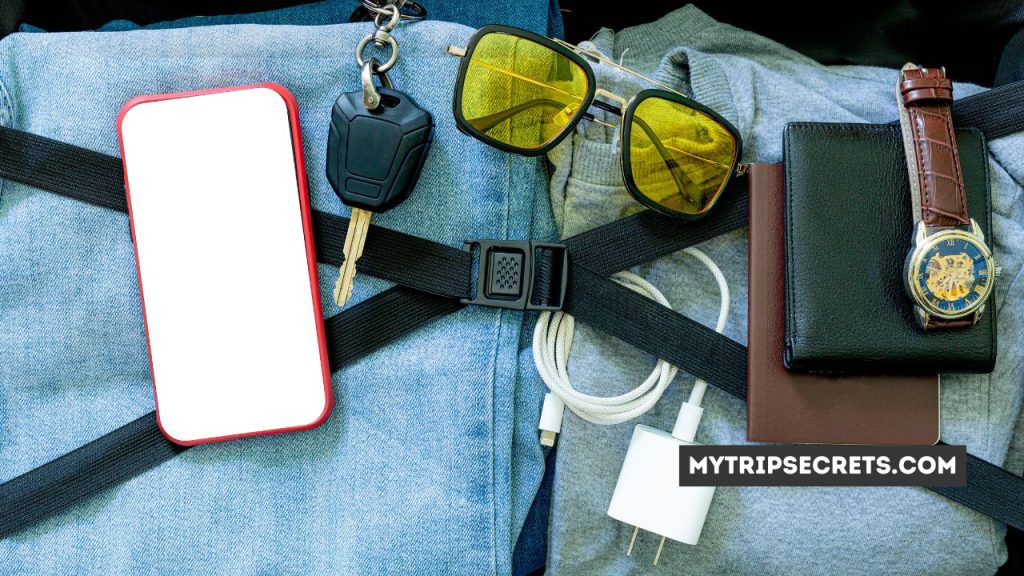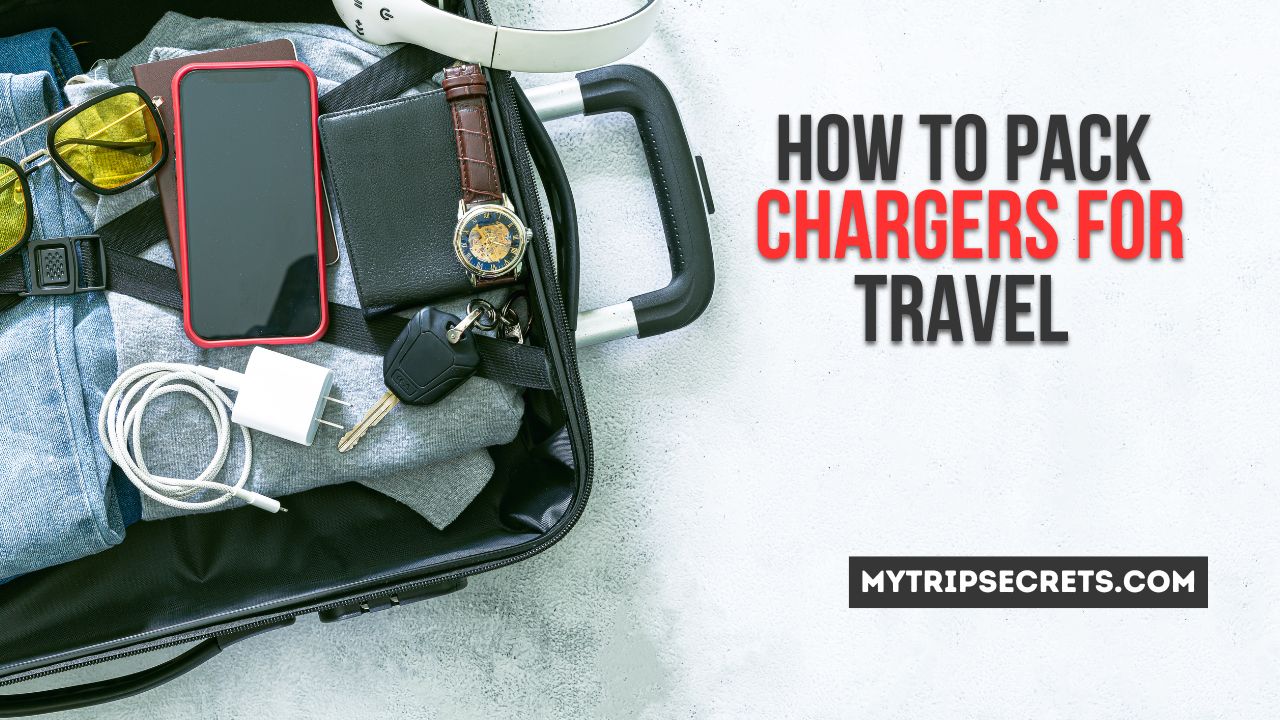Exciting as travel can be, remembering to charge your electronics can be a real pain. However, this is all avoidable if you put in the time and effort ahead of time to plan and prepare. No matter how far or near your travels take you, this all-inclusive guide will help you keep your electronic devices (smartphones, laptops, tablets, e-readers, etc.) charged and operational.
Contents
- 1 How to Pack Chargers for Travel
- 2 Determine Power Outlet Access
- 3 Gather Your Devices & Estimate Usage
- 4 Pack Wall Chargers
- 5 Battery Packs Offer Portability
- 6 Specialty Charging Tools
- 7 Organize & Label Your Charging Tools
- 8 Handling Voltage Differences Abroad
- 9 The Final Pack List
- 10 Frequently Asked Questions
- 11 Conclusion
How to Pack Chargers for Travel
Staying charged while traveling is critical these days because so much of what we do is centered on technology. From taking vacation photos to looking up ticket information, our smartphones have evolved into lifelines that keep us informed, productive, and entertained wherever we go. Running out of power threatens to diminish the delights of travel, and it frequently happens at inconvenient times. This can be avoided with careful planning and packing of chargers, cords, and backup batteries.
The idea is to tailor your charging approach to your route and destination. The solutions that work for a local road trip are likely to be vastly different from those required for an international tour spanning many nations. Access to power outlets, voltage variances, the requirement for adapters, and other variables must all be considered. Furthermore, the sorts of gadgets you travel with and how frequently you use them influence the number and capacity of chargers necessary.
Think over a few critical concerns before packing to determine what and how many charging tools you need to stay connected. To maintain batteries charged for any travel, this article provides guidance, ideas, and product recommendations. Start our path to continuous device use while traveling!
Determine Power Outlet Access
The foundation for any charging on the go plan centers on access to functioning power outlets. You need to assess if you will regularly have a place to plug in throughout your trip or if opportunities will prove scarce. Consider these questions:
- Where will you be staying and can you charge devices overnight there? Hotels and motels often provide ample outlets near beds or desks while tents and RVs may offer fewer options.
- How will you get around? Planes, trains, cars, and buses sometimes offer charging ports or AC outlets for passenger use during transport.
- What attractions and venues will you visit and do they have public USB or wall ports available? Museums, restaurants, parks, etc. allow device recharging in some cases.
- Could you experience extended time off-grid without power access for charging? Remote nature trips often lack electricity.
- What countries/regions are part of your itinerary? Outlet shapes/voltages vary globally so you may need adapters.
These details determine if you should mainly top up devices overnight where you lodge vs. needing continuous supplemental charging everywhere you go. They also indicate what type of gear makes the most sense for your situation. Let your expected access to electricity guide choices as we tackle other packing considerations.
Gather Your Devices & Estimate Usage
Next, gather all devices you will carry when traveling so you understand precisely what needs charging. Phones top most lists, but don’t overlook digital cameras, e-readers, handheld gaming systems, wireless headphones, smart watches, and anything else powered by a battery. Check your luggage as well since laptops, electric toothbrushes, and shavers also need charging.
Catalog everything into a table like this example:
| Device | Number | Charging Method | Average Uses Per Day |
|---|---|---|---|
| iPhone 12 | 1 | Lightning cable | 5 hours screen time |
| iPad Pro | 1 | USB-C cable | 3 hours streaming video |
| Sony a7R III | 2 | USB-C cable | 300 photos |
| Bose QuietComfort Earbuds | 1 | USB-C cable | 2 hours listening |
| MacBook Pro 16″ | 1 | 96W USB-C power adapter & cable | 8 hours use |
| Philips Sonicare Toothbrush | 1 | Induction glass charger | 3 minute brushing |
This provides an overview of exactly what you need to power up. Additionally pay attention to:
- Daily and weekly usage habits for each device
- Battery capacities/average runtime before needing a charge
- Charging cables or adapters required
Understanding your expected power draw allows properly anticipating charging needs. Planning charger capacity and numbers depends greatly on how often you use devices and how long batteries last. Now let’s review gear to solve any charging on the go challenge!
Pack Wall Chargers
The most direct source of power comes from AC wall outlets providing potentially hundreds of watts to rapidly charge devices. Include wall chargers for destinations guaranteeing nightly access for plugging in devices. Select chargers fitting outlet types at your destination.
USB Power Adapters/Blocks: The classic USB blocks connecting to wall outlets come in varying wattage/voltage ratings and physical shapes to match electrical systems globally.
All-in-One/Multi-Chargers: Single adapters offering 2+ USB ports prove useful for simultaneously charging multiple devices when you have outlet access.
USB Wall Warts: Directly integrate the USB port/cable along with prongs that plug directly into AC outlets for compact all-in-one charging.
Tip: Label each charger with masking tape/stickers indicating matching device(s) to avoid confusion.
Battery Packs Offer Portability
For trips with unreliable power access, pack external battery packs as your lifeline for juicing up devices anywhere. These portable all-in-one charging stations have built-in rechargeable cells storing electricity to power up plugged in gear.
Power Banks: Compact handheld banks offer affordable basic charging with lower capacity around 5,000-20,000 mAh ratings. Slip in a pocket or bag for phone top ups.
High Capacity Models: Beefy 26,000+ mAh models charge phones 5+ times and can even charge tablets/laptops in some cases. The trade-off comes in increased price/bulk.
Solar Chargers: Sun absorbing panels allow refueling battery reserves via solar energy during daytime. Great for camping/hiking trips off the grid!
When selecting capacity, allow for a minimum of 2 full phone charges or choose according to your device using the most power. Optimize portability vs capacity based on itinerary restrictions.
Specialty Charging Tools
Besides basic power banks and wall units, an assortment of unique charging gadgets can also prove useful while traveling:
Battery Cases: Protective phone cases with integrated batteries add extra runtime. Convenient but bulky.
Car Chargers: Plug into vehicle outlets for charging on the road during long drives. Useful for navigating apps.
Charging Cables: Don’t forget cables like USB, lightning, USB-C to actually transfer power! Include 1-2 extras allowing charging even if one cable fails.
Outlets Splitters/Extenders: Expand 1 outlet into 2+ and add USB ports along with AC plugs. Great for airport charging stations.
Wireless Pads: Charging pads provide fuss-free charging just by placing devices on their surface rather than plugging in cables.
Portable Solar Panels: Unfurl these panels like mats to harness the sun’s energy for eco-friendly power while camping or at the beach.
Battery Discharge Rate
Now you know about various chargers, but remember battery discharge rate also influences needs. Power hungry tablets drain faster than e-readers for example. Consequently carry enough capacity to offset your most demanding device’s discharge rate should outlets remain elusive over long durations. With gear selected, how do you actually pack it?
Organize & Label Your Charging Tools
Chaos often ensues when unpacking chargers at hotels or while desperately digging through bags seeking the correct cable for a dying phone. Organization and labeling helps avoid this fate. I recommend:
- Custom printed vinyl cable/charger wraps labeling each item
- Color coordinating bands on chargers/cables matching target devices
- Utilizing cable organizer travel cases sorting all cables/chargers
- Packing chargers needed immediately in easily accessible tech pouches rather than buried deep in luggage
These tactics distinguish nearly identical cables, identify devices, and save precious seconds scanning various cords to find the correct charger. Maintaining order from home until reaching final destinations keeps your gear and sanity intact.
Handling Voltage Differences Abroad
Voltage varies across international borders and outlets/plugs differ physically. Chargers have built in voltage regulation handling 100-240v allowing use globally.
Adapter Tips:
- Verify required adapters for destinations through travel guidebooks/apps about local electrical outlets
- Stash adapters in tech pouches vs general luggage to prevent losses
- Include 1 adapter per device needing simultaneous charging (multi-port adapters help consolidate)
- Choose quality adapters clearly stating safety certifications to prevent fires or malfunctions
Voltage Converters: Use voltage converters, transforming electricity, only for devices lacking internal voltage regulation around the 100-240v range.Hair dryers and older laptop chargers commonly fall into this category. Newer phone/tablet chargers include regulation, making converters unnecessary.
The Final Pack List

We covered many tips, now let’s review a final checklist with charger quantities generalized. Adjust and customize your actual numbers according to your device loadout.
- Cell phone wall chargers – 1 per phone
- Tablet wall chargers – 1 per tablet
- Laptop wall chargers – 1 per laptop
- Extra charging cables – 2-3 extras
- Battery pack (at minimum 5,000 mAh capacity) – 1-2
- Power strip/outlet splitter – 1
- Foreign electrical adapters (as needed) – 1 per simultaneous device charged
- Car phone charger – 1
- Color coded cable wraps – 1 per charging cable
- Tech pouches for organization – 1 pouch per person
- Cable organizer case – 1
Follow these guidelines to cover any mobile charging needs imaginable while preparing for your epic adventure!
Frequently Asked Questions
Travelers often pose various questions about power and charging on the move. Here are helpful answers to frequently asked queries:
What tips help my phone battery last longer while traveling?
Enable Airplane Mode: When not actively using cellular/data connectivity, enable airplane mode to avoid battery drain from constantly searching for signals. Disable only temporarily when you need to access data.
Adjust Screen Brightness: Dim your screen since the display drains a majority of juice. Auto-brightness tailoring to ambient lighting helps.
Disable Unnecessary Apps/Features: Turn off background refresh and push notifications for apps not required offline while traveling like social media.
Carry a Battery Pack: Recharging from external packs provides insurance against losing power at inopportune times.
Can weather impact battery life for devices?
Yes! Extreme cold drains lithium-ion batteries faster due to slowed chemical reactions. Additionally devices work harder/use more energy powering displays and radios when warmer. Avoid leaving devices sitting in very hot/cold vehicles and bring them to room temperature when possible.
Is it fine using just a car charger without an actual wall charger?
While car chargers certainly work in a pinch, making them your primary travel charger poses some risks:
- Inconsistent charging while driving since devices connect and disconnect repeatedly
- Potential overheating of devices in hot vehicles
- Limited nightly recharging capacity unless sleeping in your vehicle!
- Vehicle maintenance issues could render your car USB ports unusable
Car chargers work well as backup options, but carrying dedicated AC wall chargers proves wise for steady overnight refueling.
How many watts or what voltage charger works with all my devices?
For ultimate global compatibility, Quick Charge 3.0 USB-C PD chargers with 45 watts output, 5 volts/3 amps, 9 volts/3 amps, and 12 volts/3 amps charge virtually any phone, tablet, or laptop. Chargers meeting these specs charge devices at max speeds while handling worldwide voltages.
Conclusion
Rather of feeling helpless staring at empty, depleted screens, charging gadgets while adventuring allows you to capture great memories. You may stay productive and connected even when traveling to other countries or isolated areas without access to the grid if you prepare ahead of time and bring charging gear that is designed for your specific itinerary. With these pointers in mind, you can put your worries about dead devices to rest and enjoy your trip. Get going, make some unforgettable moments, and charge up with peace of mind.

